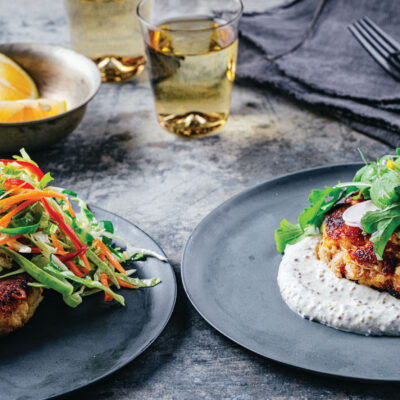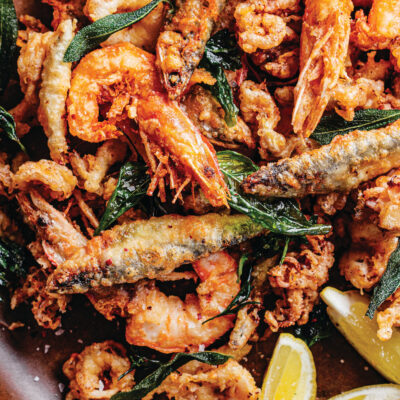Nan-e Barbari
One of our most dramatic-looking breads is nan-e barbari, a 14-inch/35cm oblong. A defining characteristic of the barbari, apart from its shape, is that its surface is spread with roomal, a flour and water paste, before baking, which puts a layer of moisture directly on the bread. This ancient bread-baking technique isn’t seen much anymore, since steam ovens are common in bakeries. This recipe lets you create a bread with a great crust without having to introduce steam into the oven.
At the bakery, we make one long loaf, but unless you have a really big oven, you will likely make two lovely oblongs as directed here. Nan-e barbari makes a dramatic addition to any cheese plate. I especially like it served with feta, cucumbers, and olives.
Recipe excerpted from The Hot Bread Kitchen Cookbook by Jessamyn Waldman Rodriguez.
Nan-E Barbari
Ingredients
- 2 cups (450 g) lukewarm water
- 2 1/4 teaspoons active dry yeast (1 envelope)
- 4 cups (510 g) bread flour, plus more for shaping
- 2 teaspoons kosher salt
- Canola oil
- 2 teaspoons all-purpose flour
- 1/2 teaspoon sugar
- 1/3 cup (80 g) cool water
- 1 teaspoon nigella seeds (aka black onion seeds)
- 1 teaspoon sesame seeds
Instructions
1. Stir together the water and yeast in a stand mixer fitted with a dough hook.
2. Add the bread flour and salt and mix on low speed until the flour is integrated. Increase the speed to medium-high and mix until the dough is elastic, about 6 minutes. The dough should be cleaning the sides of the bowl. Coat the inside of a large bowl with canola oil and transfer the dough to it. Cover the bowl with plastic wrap or put the whole bowl in a large plastic bag and let rest at room temperature until the dough is softer than a firm balloon, is supple, and holds an indentation when pressed lightly, about 1 hour.
3. Turn the dough out onto a lightly floured work surface. Divide the dough in half (each piece should weigh about 490 g). Gently form each piece into a rectangle and perform a log roll. Loosely cover the pieces of dough with plastic wrap or a plastic bag and let rest at room temperature until the dough has risen and is supple, about 30 minutes.
4. Meanwhile, combine the all-purpose flour, sugar, 1/2 teaspoon canola oil, and the water in a small saucepan. Cook the flour paste over medium heat, whisking, until bubbles form around the edges and it becomes thick and opaque, about 2 minutes. Set aside to cool.
5. Put a pizza stone on the lowest rack of the oven and preheat to 450°F/235°C. Let the stone heat up for at least 30 minutes.
6. Line the back of a baking sheet with parchment. Put one piece of dough on the parchment; leave the other covered and in a cool place. Gently pulling the ends and pressing down on the dough, extend it into a 14 × 5-inch/35 × 13 cm rectangle. Using your fingers, press 5 deep lengthwise ridges into the dough being sure not to break the dough. Rub half of the flour paste over the surface and sprinkle with half of the nigella and sesame seeds.
7. Slide the dough and parchment onto the hot stone and bake until the bread has puffed up and is golden brown, about 18 minutes. Transfer the loaf to a wire rack, dispose of the parchment, and repeat the process to make the second loaf. Serve warm. Store any leftovers in an airtight plastic bag at room temperature for up to a couple of days.
Reprinted from The Hot Bread Kitchen Cookbook. Copyright © 2015 by Jessamyn Waldman Rodriguez. Photos copyright © by Jennifer May and Evan Sung. Published by Clarkson Potter, an imprint of Penguin Random House, LLC.
• The Best Indian Flatbread to Make at Home
• How to Make Popovers
• Irish Country Bread







